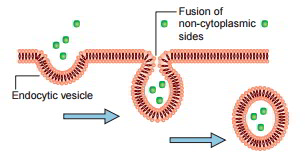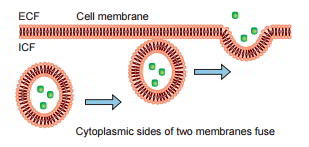Vesicular transport mechanisms are associated with the transport of macromolecules such as big protein molecules which can neither travel through the membrane by diffusion nor by active transport mechanisms The vesicular transport mechanisms consist of endocytosis, exocytosis and transcytosis.
Endocytosis
Endocytosis is the process where the substance is carried into the cell by in folding of the cell membrane around the substance and internalising it. It is additional classified into 3 types:
- Pinocytosis, i.e. cell drinking describes the process of swallowing up liquid substances by the enfolding of cell membrane, e.g. reabsorption by renal tubular epithelial cells.
- Phagocytosis, i.e. cell consuming is the process of engulfing of strong particles, such as bacteria, dead tissue and foreign particles by the cells The process of phagocytosis includes 3 actions: (i) the accessory phase, (ii) the engulfment phase and (iii) killing or destruction phase.
- Receptor-mediated endocytosis. In this process the substance to be carried binds with the unique receptor protein present on the cell surface The receptor protein–substance complex is then swallowed up by the cell membrane by the process of endocytosis. Transport of iron and cholesterol into the cells happens by receptor mediated endocytosis.
Exocytosis
Exocytosis is reverse of endocytosis, i.e. by this process the substances are expelled from the cell without going through the cell membrane. In this process, the substances which are to be extruded are gathered in the form of granules or vesicles which move to the cell membrane. Their membrane then merges to the cell membrane. The area of blend breaks down launching the contents to the outside and leaving the cell membrane undamaged. Release of hormones and enzymes by secretory cells of the body happens by exocytosis. The process of exocytosis needs Ca2+ and energy together with docking proteins.
Transcytosis
Vesicular transport within the cell is called transcytosis or cytopempsis. It is rather just like exocytosis and endocytosis. 3 fundamental actions associated with this process are: (i) vesicle formation, (ii) vesicle transportation and (iii) docking in the cell.
Mechanism of Transcytosis
Cell confines the extracellular substance by invagination of the cell membrane to forma vesicle. Vesicle then moves across the cell and thrown away through opposite cell membrane by methods of exocytosis. Transcytosis includes the receptor-coated pits as in receptor-mediated endocytosis. Receptor protein finishing the pits in this process is caveolin and not clathrin. Transcytosis is likewise called, vesicle trafficking or cytopempsis.
Transcytosis plays an essential role in selectively carrying the substances in between 2 environments across the cells with no unique modification in the composition of these environments. Example of this type of transport is the movement of proteins from capillary blood into interstitial fluid across the endothelial cells of the capillary Lots of pathogens like human immunodeficiency infection (HIV) are likewise carried by this mechanism.



 (55 votes, average: 4.62 out of 5)
(55 votes, average: 4.62 out of 5)